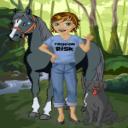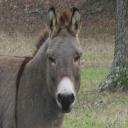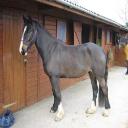Yahoo Answers is shutting down on May 4th, 2021 (Eastern Time) and beginning April 20th, 2021 (Eastern Time) the Yahoo Answers website will be in read-only mode. There will be no changes to other Yahoo properties or services, or your Yahoo account. You can find more information about the Yahoo Answers shutdown and how to download your data on this help page.
Trending News
why are snaffles, hackamores and sidepulls preferred over a curb bit when training young horses?
explain plz!!!!!
11 Answers
- bullvedereLv 61 decade agoFavorite Answer
the first thing you want to teach to a young colt is whoa! the rest will come later with a progression of bits.some to teach turning some to teach neck reining but always in a progression,so in other words you start with a soft bit to keep the mouth soft then progress in severity of bits so when you end up with the finnishing bit you are using the least pressure on the bit with kitten hands.
Source(s): 4th generation cowboy/rancher - 1 decade ago
Technical info - but will explain alot-
With a curb - there is a shank - even a snaffle (Broken mouth peice) can be a curb if there is a long shank that you hook your reins too. The shanks have a location to hook something called a "CURB STRAP" - or - Chin strap. These are often made of chain - sometimes leather. When you pull back on the reins, what is happing is the leverage (longer the shanks the more leverage - and the harsher the bit becomes) is now being placed under the chin and tightens that strap - making the horse look for relief - (Stop/back)
Some Hacks work in the same way (NOT BOSALS - HACKS) They work on nose pressure instead of lips/bars of mouth. But they can be VERY SEVERE - and are often times more severe then some bits!
With a Snaffle (O RING or D Ring) the bit has no shank - therefore no leverage. Sometimes you'll see a curb strap on the bit - but this is only to keep the bit centered in the mouth of the horse - so it doesn't pull through the lips - When you pull on the reins of the snaffle O ring - you're actually only applying pressure to the horses lips - the corners to be exact. There are many different sizes to the mouth peices on these snaffles - the bigger thicker smooth one are gentler - think about it - would you prefer the soft smooth edge on your lips - or a tiny thin wire on your lips - The smaller bits are much more severe! ANY BIT - in the wrong uneducated hands can be painful!
With educated hands - a trainer could get on a green colt with a snaffle/curb bit and teach them plenty - its all in the reward - Educate yourself as you are doing - and remember to ALWAYS reward quick and often! Stay light!
- PRSLv 61 decade ago
I prefer to use the least destructive or harmful tack that I can get away with. I would use a sidepull first, then hackamore, then snaffle, then a bit with a snaffle mouth piece but with a curb chain as the last step. I've never needed a solid mouth, twisted wire or high port on any horse I've ever ridden and can't imagine a situation where I would put such things in any horse's mouth.
Smart people go with the softest control device they can possibly use. I prefer to go bitless when ever possible. A lot of apparently crazy behavior by horses being ridden is directly related to pain caused by a bit.
- GXSRgal87Lv 51 decade ago
A young horse's mouth is still soft, so a bit that is gentle needs to be used. The snaffle is the gentlest bit and prevents the horse from getting a hard mouth too early. Using a curb on a youngster is truly unnecessary and may cause damage down the road.
- How do you think about the answers? You can sign in to vote the answer.
- Anonymous1 decade ago
I am not sure if you are talking about Western riding?, but certainly, here in Britain, we would never ride a young horse in such a bit.
We ride on a contact, so consequently, a curb on a freshly broke or baby, would send it crazy or break its jaw.
In fact, we would only use a curb along side a snaffle (in a double bridle, at a level when a higher degree of collection was required)
You would not expect the same collection from a young horse.
- 1 decade ago
If you use a curb bit, the young horse is more likely to have a hard mouth as and adult. I prefer snaffles for any age horse, but especially for young ones.
- TB eventer!Lv 41 decade ago
because a young horse is not used to having a piece of metal in his mouth, and will naturally respond quickly to slight pressure on a soft bit, there is no need for a harsher bit....
if you start a horse with a curb it will fear being ridden due to the pain in its mouth, and will not understand the basics..
the side pull and hacakmore are preferred because they don't use any contact with the horses mouth so are generally softer.. and more direct. pull left go left, its simpler for a young horse
note-hackamores can be VERY harsh depending on what you use/how you use them. if you don't want a bit try a side pull first.
- MyNutmegLv 61 decade ago
snaffles are prefered because they are much softer on the horses mouth and you don't need a curb bit until later, also a curb in the wrong hands can do a lot of damage to a horses mouth and simply isn't needed - why put more tack on a horse than absolutly necessary!
- 1 decade ago
you surely do not want to use a curb on a young horse. use a snaffle or a hackamore on a young horse to teach him to give to bit pressure and teach him to bend and flex. you only want to use a curb bit on a well broke and older horse.
- BarefoottrimmerLv 71 decade ago
At training level, you use training equipment. A curb is a more severe bit and is used for a more advanced level of horse in specific disciplines. You never want to subject a young horse who knows nothing about handling a bit, learning direction, and communication to such a severe piece of equipment. It is wrong, cruel, and inappropriate. Sorry, but anyone who would ask such a question appears to have very little knowledge of horses so I presume that is your situation. You want to keep your young horse as light as possible so that he will respond to the slightest communication cues. We should always be kind to your horses at all stages of their lives. If you keep things appropriate, your horse will learn well and be responsive, and will never know fear and pain. Make sense???








